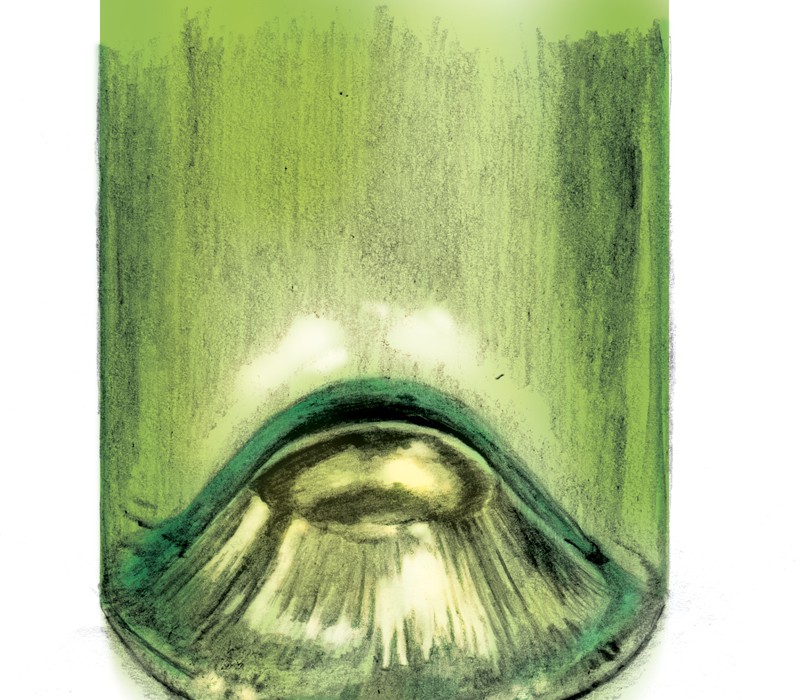By Mugroso
Illustration by Justin Mortzheim
For the uninitiated, you may not even know it’s there.
The punt is the inverse indentation at the base of a wine bottle. Some people use the punt to assist in pouring wine gracefully from the bottom of the bottle instead of choking the bottle about the neck to pour. Some wines use a punt to give the bottle glass greater structural integrity in avoidance of breakage. But despite being part of the wine bottle structure for hundreds of years, the punt remains a deeply mysterious and controversial innovation in glass.
Punt historians (you know who you are) have suggested that the punt was a derivative of the glass-blowing process eons ago. When a glass bottle was blown, the process of handling the soft glass resulted in a spur or scar of glass where it was removed from the blowing instrument. The glassblower indented the scar to prevent the spur from scratching tables or cutting the hands of those handling the bottles. There is some logic in this line of reasoning.
However, it is just as often suggested that more talented and experienced glass blowers could have mitigated this imperfection and the indentation by fine-tuning the end product if indeed that was the goal. That the punt remains, we are left to assume through logical extension, was either the result of lazy, ill-trained glass blowers or the punt remained with purpose.
But for what purpose?
We know glass was first made in 3000 BCE in what is now (or left of) Syria. Around 1730 BCE, glass made its first appearance in southern Asia. Glass itself and glass-blowing as an art form are acknowledged as Roman innovations. And the Romans liked a flagon of wine.
But it was not until the early 17th century CE that glass wine bottles came to the fore—a time that also saw the first corks being used as closures. Coal-fired furnaces allowed heavier and darker glass to be blown. Previously, if wine was shipped, it was packaged in clay vessels rather than glass, which broke too easily. Somewhere in this era of innovation, the punt arrived.
Champagne and sparkling wine bottles are notoriously “puntificated.” These wines are bottled under pressure, thanks to their bubbly construct, so the glass has to be very strong to withstand the pressure inside. We are told that the punt gives the bottle structural integrity to withstand the volatile pressure inside. We will have to take this notion on face value. (This columnist requested funds to hire a structural engineer to test this theory, but that request was turned down by always frugal and occasionally niggardly PDX Mag managing editor Charity Heller.
We do know from the experience of attending any number of PDX Mag issue launch parties that Champagne and sparkling wine is under pressure thanks to the magazine staff’s near-obsession with “sabring” sparkling wine bottles. Again, however, this is mere anecdotal evidence.)
There is another common belief that the punt allows ease of stacking wine bottles during secondary fermentation, which often occurs in the bottle. This may have some merit, at least in wine industry practice, but I cannot help but remain dubious given that I often have trouble keeping one bottle upright on a table. The mystery remains.
Failing in my attempt to hire a structural engineer to prove punt theories, I turned to the next best authority on such technical matters—Wikipedia. The people’s encyclopedia and final say-so about the facts of life is chockablock with ideas for the punt’s existence. The glassblower prowess argument noted above is listed first, and the sparkling wine theory as well. But there are many other points of rationale proffered.
- A flat bottom is easier to tip over, thus the punt.
- The punt accumulates sediment around it in a ring allowing more of the wine to be drunk or decanted sediment-free.
- It provides a grip for “riddling” wine bottles, especially sparkling wines. Riddling is the shaking and twisting of wine bottles by hand before racking punt up at a 45-degree angle to coalesce the lees that fall out prior to dégorgement or disgorging.
- In a conspiratorial bent, it is suggested that the punt removes some of the apparent volume of the bottle, thereby suggesting to the purchaser that he is getting more wine than he bargained for, while actually he is buying less. One local distributor acknowledged that some wine entities messed around with this deceitful “innovation” before being busted by consumers.
- The punt prevents the wine bottle from “resonating” during shipment and thus prevents shattering. (Our erstwhile engineer seems to have added this item to the Wiki entry.)
My favorite, however, is that the deeper and more pronounced the punt, the finer the wine. Our Wikiian proletariat suggests this theory is an old wives’ tale. Without more counter evidence, however, I am glomming onto this one until I am definitively proven wrong before acquiescing.
What I needed was an expert or four. There is proof in numbers…right? But first, I needed some data.
Down to the cellar I went. Armed with the delicate instruments of the punt research trade, I used my thumb and index finger to measure a few punts. Here’s what I found relative to punt depth (measurements are approximate, as my daughter left her ruler at school):
- Italian Brunello and French Bordeaux: roughly 1 inch deep
- Pinot noir and syrah: approximately 1.5 inches
- Champagne and sparkling wines: about 1.25 inches
But the winner-winner-chicken-dinner of the punt off? A well-aged bottle of Domaine de la Romanée-Conti Richebourg Grand Cru, Côte de Nuits at a whopping 2.25 inches deep. Now that’s a punt!
Maybe there is something to this finer-the-wine-the-deeper-the-punt argument. The DRC Richbourg is not your everyday spaghetti wine.
Having been around the industry for awhile, I knew some heavy punters to check in with. They would have the answers.
But, it turns out, they didn’t…winery owners, winemakers, distributors…one after another grasped at air to answer my query. Structural integrity dominated their collective responses. No one seems to think there is anything to the ease of pouring argument. Only one mentioned the sediment collection theory.
Since at least the early 1700s, wine bottles have been used to deliver wine to consumers. And over that 300-plus year era, the mystery of the punt remains.

